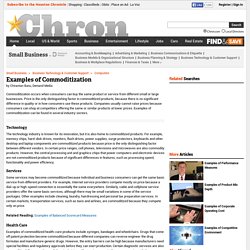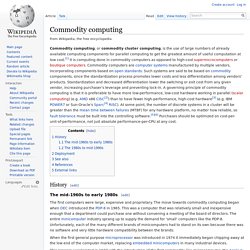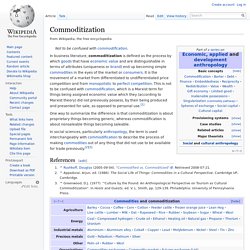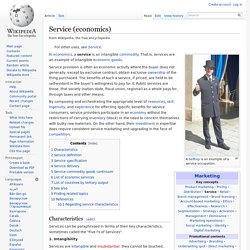

Suppliers to the BMW 3 and 4 Series. Bmw bom suppliers. Kennisgeving voor omleiding. Tobias Titus. Examples of Commoditization. Commoditization occurs when consumers can buy the same product or service from different small or large businesses.

Price is the only distinguishing factor in commoditized products, because there is no significant difference in quality or in how consumers use these products. Companies usually cannot raise prices because consumers can shop at competitors offering the same or similar products at lower prices. Examples of commoditization can be found in several industry sectors.
Technology The technology industry is known for its innovation, but it is also home to commoditized products. Services Some services may become commoditized because individual and business consumers can get the same basic service from different providers. Related Reading: Examples of Balanced Scorecard Measures Health Care Examples of commoditized health-care products include syringes, bandages and wheelchairs. Industrial Considerations About the Author. Commodity computing. Commodity computing, or commodity cluster computing, is the use of large numbers of already available computing components for parallel computing to get the greatest amount of useful computation at low cost.[1] It is computing done in commodity computers as opposed to high-cost supermicrocomputers or boutique computers.

Commodity computers are computer systems manufactured by multiple vendors, incorporating components based on open standards. Such systems are said to be based on commodity components, since the standardization process promotes lower costs and less differentiation among vendors' products. Standardization and decreased differentiation lower the switching or exit cost from any given vendor, increasing purchaser's leverage and preventing lock-in. A governing principle of commodity computing is that it is preferable to have more low-performance, low-cost hardware working in parallel (scalar computing) (e.g. History[edit] The mid-1960s to early 1980s[edit] Deployment[edit] Commoditization. One way to summarize the difference is that commoditization is about proprietary things becoming generic, whereas commodification is about nonsaleable things becoming saleable.

In social sciences, particularly anthropology, the term is used interchangeably with commodification to describe the process of making commodities out of any thing that did not use to be available for trade previously.[2][3] Jump up ^ Rushkoff, Douglas (2005-09-04). "Commodified vs. Commoditized". Retrieved 2008-07-21. Commodity. There is another important class of energy commodities which includes electricity, gas, coal and oil.

Electricity has the particular characteristic that it is usually uneconomical to store; hence, electricity must be consumed as soon as it is produced. There is a spectrum of commoditization, rather than a binary distinction of "commodity versus differentiable product". Few products have complete undifferentiability and hence fungibility; even electricity can be differentiated in the market based on its method of generation (e.g., fossil fuel, wind, solar), in markets where energy choice lets a buyer pay more for renewable methods if desired. Many products' degree of commodification depends on the buyer's mentality and means.
For example, milk, eggs, and notebook paper are considered by many customers as completely undifferentiable and fungible; lowest price is the only deciding factor in the purchasing choice. Etymology[edit] Global commodities trading company[edit] Service (economics) A bellhop is an example of a service occupation.

Service provision is often an economic activity where the buyer does not generally, except by exclusive contract, obtain exclusive ownership of the thing purchased. The benefits of such a service, if priced, are held to be self-evident in the buyer's willingness to pay for it. Public services are those, that society (nation state, fiscal union, regional) as a whole pays for, through taxes and other means. By composing and orchestrating the appropriate level of resources, skill, ingenuity, and experience for effecting specific benefits for service consumers, service providers participate in an economy without the restrictions of carrying inventory (stock) or the need to concern themselves with bulky raw materials.
On the other hand, their investment in expertise does require consistent service marketing and upgrading in the face of competition. 1. 2. Services are perishable in two regards 3. 4. Each service is unique. 5. Social services. Types Of Commodities. All commodities are fungible, but not all commodities are created the same.

Generally speaking, investors break commodities down into two categories: "soft" and "hard. " Soft Commodities Soft commodities are typically grown, while hard commodities are typically mined or extracted. Orange juice, corn, wheat, lean hogs, coffee, sugar and cocoa beans are all examples of "soft" commodities. Many soft commodities are subject to spoilage, which can create huge volatility in the short term; if you're sitting on 30,000 pounds of cocoa beans and the price drops, you might have to dump them onto the market whether you want to or not.
Producers are often large players in the "softs" market. Hard Commodities "Hard" commodities are typically mined from the ground or taken from other natural resources, e.g., gold, oil, aluminum. Because "hard" commodities are easier to handle than most "softs," and because they are more integrated into the industrial process, most investors focus on these products.